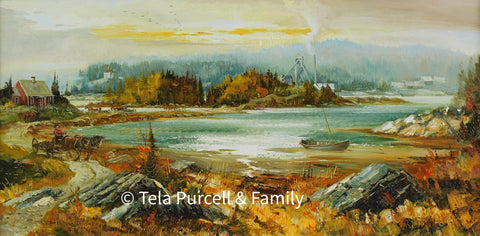Nova Scotia Gold Mining Series
Seabright Collection, Nova Gold Mine Districts

Commissioned by Seabright Resources Inc. (now known as WMC International Limited), in 1986 Joseph travelled and painted on-site at the numerous former gold mine sites of Nova Scotia.
He completed a series of 14 oil paintings of these former gold mining sites including Montague, Oldham, Tangier, Waverley, Moose River, Goldenville, Goldboro, Seabright, Wine Harbour, Caribou Mines, the Ovens (as seen in picture above), Harrigan, and Beaver Dam.
The paintings are on display at the Museum of Industry and donated by WMC International Limited - Americas Division and Western Mining Corporation, Australia.
Montague

"Gold mining started in this district during 1863 after earlier prospecting. A major advantage for this area was its proximity to Halifax and Dartmouth and their supplies and services. This scene shows a well developed and busy site."
Oldham

"This is one of the oldest gold districts in the province, with the original discovery in the spring of 1861. The scene depicts a main mill set up at this active gold camp around the turn of the century. Some stamp mills at this productive site were water-powered."
The Ovens

"In June, 1861, gold was reported found in this area of great natural beauty. It was one of the earliest discoveries and activity was limited, with miners using picks, shovels, pans, sluices and rockers to recover the gold."
Forest Hill

"In this scene the miners are portrayed changing shifts at one of the most remote mines developed in the province. Gold was discovered here in June 1893, and eventually the camp developed into a small community, complete with a school, a church, general stores and a saloon. In this painting of an early fall morning, the famous Modstock mill sits next to a small brook and the schoolhouse shaft headframe is in the right foreground." Painting is one of a series by Purcell on display at the Museum of Industry and donated by WMC International Limited - Americas Division and Western Mining Corporation, Australia. Forest Hill is located northeast of Country Harbour, Guysborough County, NS.
Crouse's Cabin, Beaver Dam Mine
"The cabin portrayed in this painting was built during the late 1920s by miner Johnnie Crouse. Living and working just north of Crusher Lake in the Beaver Dam gold district, Crouse spent long days digging for gold quartz, and crushed it by hand using a steel mortar and pestle."
Wine Harbour
"Named for the cargo of a wrecked ship, Wine Harbour was regularly visited by supply ships carrying coal and other necessities for the operation of the mill depicted in this painting, and others in the area. Gold mining began in this district in 1862 and at its height, saw five or six mills in operation."
Goldboro
"This district was the site of the famous Boston Richardson Mine which employed approximately 250 men and boasted its own railway for hauling coal and supplies from Isaacs Harbour to the mill at Gold Lake. It was one of the major gold mines of the late 1800s in Nova Scotia."
Goldenville

"This winter scene depicts Goldenville in the early 1860s. The town's existence was based solely on the gold mining industry and for a time it thrived."
Caribou

"In the summer of 1864, gold quartz was discovered in this area by Josiah Henning. Camps were established by 1867 and mining continued in this area through to the 1940s."
Hurricane Mine
"The site of one of the richest mines in the province, Hurricane Point sat along Isaac's Harbour, across from North Star Mine. It was at this site that one of the most well-known figures in Nova Scotian gold mining history, Dr. Faribault, went to work after leaving a larger company, GSC."
Waverly

"The discovery of gold near Muddy Pond in 1861 led to the establishment of the gold mining industry in the Waverley district. During the period depicted in this painting, the camp was well established and the headframes from such famous mines as American Hill rise above the village."
Bickerton Light

"Supply ships were vital to the operation of the often remote gold mines in Nova Scotia and the beacons were what brought them safely to shore. Carrying everything from coal for the stamp mills to personal supplies for the miners and their families, the arrival of a ship in the harbour was a very welcome sight."
Moose River

"Now a quiet former mining town, Moose River was once the location of a number of mines, their head frames seen in the background of this painting. The mine became internationally known in 1936 when the mine caved in and a desperate rescue was launched. All but one of the men trapped survived."
Tangier

"The site of the first discovery of gold in Nova Scotia in 1860, Tangier was filled with prospectors and miners within a year. This gold find was considered quite important at the time and gained interest from as far away as Europe. Portrayed here are Princess Clotilde and Prince Napoleon surveying the digging."
Sources:
- http://novascotiagold.ca/theme/art/purcell-eng.php
- https://archives.novascotia.ca/meninmines/results/?Search=&Theme=on&Theme1=on&SearchList1=all&Language=English&Start=316
- Photographs by Bob Lewis



